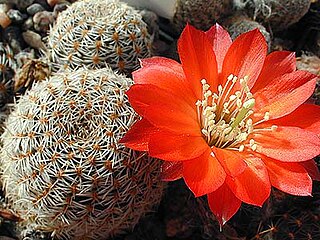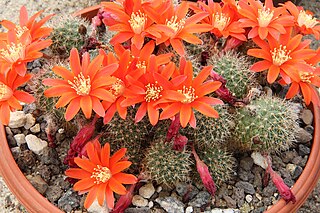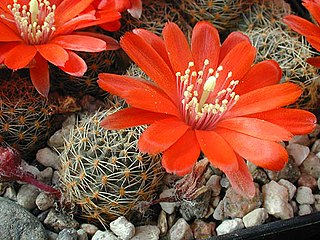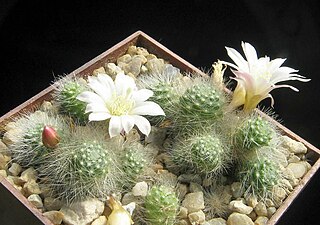
Rebutia is a genus of flowering plants in the family Cactaceae, native to Bolivia and Argentina. The limits of the genus have varied widely, depending on whether genera such as Aylostera and Weingartia are included or treated separately. As of December 2024, Plants of the World Online accepted only three species of Rebutia. A very large number of plants that have been treated in cultivation as species of Rebutia are now generally regarded as varieties, forms or synonyms of a much smaller number of species, or have been transferred to other genera. Plants treated as Rebutia are generally small, colorful cacti, globular in form, which freely produce flowers that are relatively large in relation to the body. They have no distinctive ribs, but do have regularly arranged small tubercles. They are considered fairly easy to grow and they may produce large quantities of seeds that germinate freely around the parent plant.

Cleistocactus is a genus of flowering plants in the cactus family Cactaceae, native to mountainous areas - to 3,000 m (9,843 ft) - of South America. The name comes from the Greek kleistos meaning closed because the flowers hardly open.

Pereskia is a small genus of about four species of cacti that do not look much like other types of cacti, having substantial leaves and non-succulent stems. The genus is named after Nicolas-Claude Fabri de Peiresc, a 16th-century French botanist. The genus was more widely circumscribed until molecular phylogenetic studies showed that it was paraphyletic. The majority of species have since been transferred to Leuenbergeria and Rhodocactus. Although Pereskia does not resemble other cacti in its overall morphology, close examination shows spines developing from areoles, and the distinctive floral cup of the cactus family.

In 1984, the International Organization for Succulent Plant Study set up a working party, now called the International Cactaceae Systematics Group, to produce a consensus classification of the cactus family, down to the level of genus. Their classification has been used as the basis for systems published since the mid-1990s. Treatments in the 21st century have generally divided the family into around 125–130 genera and 1,400–1,500 species, which are then arranged in a number of tribes and subfamilies. However, subsequent molecular phylogenetic studies have shown that a very high proportion of the higher taxa are not monophyletic, i.e. they do not contain all of the descendants of a common ancestor. As of August 2023, the internal classification of the family Cactaceae remained uncertain and subject to change. A classification incorporating many of the insights from the molecular studies was produced by Nyffeler and Eggli in 2010.

Armatocereus is a genus of mostly tree-like cacti from South America. These species have a conspicuous constriction at the end of the annual growth. The flowers are mostly white, with a more or less spiny ovary. The fruits are mostly spiny.

Pilosocereus is a genus of cactus native to the Neotropics. Tree cactus is a common name for Pilosocereus species. The genera Caerulocereus and Pseudopilocereus are synonyms of this genus.

Aylostera, is a genus of cactus, native to central Bolivia and north western Argentina. Aylostera was formerly sunk into a broadly circumscribed genus Rebutia, but molecular phylogenetic studies from 2007 onwards showed that when defined in this way, Rebutia was not monophyletic, leading to the resurrection of Aylostera.

Reicheocactus is a monotypic genus of cactus in the family Cactaceae, native to north western Argentina. It has only one known species, Reicheocactus famatimensis.

Weingartia is a genus in the family Cactaceae, with species native to Bolivia and Argentina. It was formerly included in Rebutia, but molecular phylogenetic evidence suggested that it was distinct from that genus. As of December 2024, it was treated as separate genus by Plants of the World Online, and recognized as an alternative generic name in the third edition of the CITES Cactaceae Checklist. It may also be treated as Rebutia subg. Weingartia.

Grusonia is a genus of opuntioid cacti, originating from the North American Deserts in Southwest United States and northern Mexico, including Baja California. Authors differ on precise boundaries of the genus, which has been included in Cylindropuntia. Corynopuntia, also known as club chollas, is now a synonym, with the genus originally being described by Knuth in 1935. Molecular phylogenetic studies suggest that it should be included in Grusonia, a view accepted by Plants of the World Online as of June 2021.

Opuntioideae is a subfamily of the cactus family, Cactaceae. It contains 15 genera divided into five tribes. The subfamily encompasses roughly 220–250 species, and is geographically distributed throughout the New World from Canada, to Argentina. Members of this subfamily have diverse habits, including small geophytes, hemispherical cushions, shrubs, trees, and columnar cacti consisting of indeterminate branches or determinate terete or spherical segments.

Rebutia minuscula is a species of cactus from South America found in northern Argentina and Bolivia. It is the type species of the genus Rebutia. As its synonym Rebutia senilis it has gained the Royal Horticultural Society's Award of Garden Merit. Its cultivars 'Krainziana', 'Marsoneri' and 'Violaciflora' are also listed as having gained the Award of Garden Merit.

Aylostera albopectinata is a species of Aylostera from Bolivia.

Aylostera fiebrigii, the orange crown cactus or flame crown, is a species of flowering plant in the cactus family that is native to exposed rocky plateaux in the Bolivean Andes, at altitudes of 2,100–4,000 m (6,900–13,100 ft) above sea level. It consists of a solitary ball some 15 cm (5.9 in) in diameter, covered in tubercles and silky hairs, with brilliant orange daisy-like flowers. In time these balls multiply to form mounds.

Soehrensia huascha, is a species of Soehrensia in the Cactaceae family, found in north western Argentina. First published in Cactaceae Syst. Init. 29: 5 in 2013.

Aylostera pulvinosa, synonym Rebutia pulvinosa, is a species of cactus in the genus Aylostera, native to Bolivia. Aylostera albiflora has been treated as Aylostera pulvinosa subsp. albiflora.

Aylostera pygmaea, synonyms including Rebutia pygmaea, is a species of cactus in the genus Aylostera, native to Bolivia and northwest Argentina. It has gained the Royal Horticultural Society's Award of Garden Merit.
Aylostera atrovirens is a species of flowering plant in the family Cactaceae, native to Bolivia and northwestern Argentina. It was first described by Curt Backeberg in 1936 as Lobivia atrovirens.
Aylostera leucanthema is a species of flowering plant in the family Cactaceae, endemic to Chuquisaca Department, Bolivia. It was first described in 1975 as Rebutia leucanthema.

Aylostera albiflora, synonym Rebutia albiflora, is a species of flowering plant in the family Cactaceae, native to Bolivia. It was first described by Curt Backeberg in 1963 as Rebutia albiflora.


















